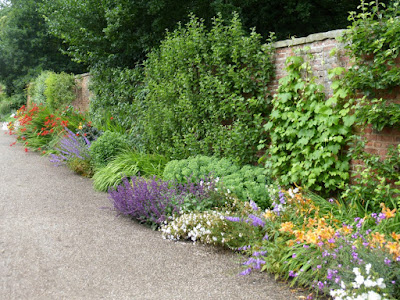In its day, spanning the Georgian to Victorian periods, Stowe was one of England's greatest houses, rivaling Blenheim and the other greatest specimens. The Temple...Grenville family accumulated great wealth via military and political service, and lusted after the highest of titles, that of duke. This they finally achieved in 1823, from George IV, flip-flopping for his benefit from Whig to Tory. By the mid-1840s, the 2nd duke had run up debts of 100 million pounds, was called "the greatest debtor in the world," and Stowe, as well as the many other houses and estates of the Temple...Grenville family was slowly sinking beneath the waves. In 1848, everything not bolted nor cemented down was sold. The forests of one of England's grandest and most historic landscape gardens were logged. In 1922, the last family owner of Stowe sold it for 50,000 pounds to an individual who simply wished to avoid seeing the great house turned into a quarry. From him, it passed to the incipient Stowe School, which has spent most of the past century valiantly seeing to the preservation and renovation of the place. The vast gardens came to the National Trust in 1989, and are being returned to their former majesty. Recounting Stowe's history more than this is beyond my skill or time, but the interested reader--and it is an interesting story--can refer easily to one of
Wikipedia's longest entries, "Stowe House."
 |
| Stowe House, southern view |
 |
From the house looking to the great Corinthian Arch and beyond to the town of
Stowe; don't miss the flanking Doric temples |
 |
| Closer up, south side |
 |
| Closer up of the north side and one of its colossades |
 |
Viscount Cobham, owned Stowe 1697-1749, and was chiefly responsible for its
building |
 |
| 2nd Earl Temple, owner, 1749-1779 |
 |
The place is now a fairly elite coed private school (US private), you understand;
we were fortunate to be there between sessions and to enjoy a fairly full tour of
the house |
 |
In the library; Stowe's vast collection of books and manuscripts was sold in 1848;
this is the school library! |
 |
| In one of the renovated great rooms |
 |
| Oculus in the Grand Saloon, modeled after the Pantheon |
 |
Thus; perhaps the most opulent of all the great halls; Queen Victoria is said to have
been repulsed (repelled?) by Stowe's opulence |
 |
Look in the center and you'll see a tennis ball left in place as a memorial to the
time when the schoolboys had a fuller run of the place |
 |
Augustus now presides over the bar (an event of some sort had
occurred the previous evening) |
 |
| In the lunchroom |
 |
| Cafeteria service area |
 |
We couldn't help notice one of the school's honored graduates, Christopher Robin
Milne, whose life at Stowe was one of relentless torment from his schoolmates,
we were told; I've been reading a good bit of the Pooh-corpus to Penelope and
have often thought of Dorothy Parker's famous review of Milne ("Tonstant weader
fwowed up"); Christopher Robin went on to Cambridge, we see |
 |
| Notice of sale of Stowe's contents |
 |
| More; thus passes the glory of the world, Gloria |

























































